Skift Take
"The notion that we should allow others to chart our destiny is anathema to the thinking certainly of me and others." That's the hard/soft power Emirates is projecting around the globe.
Emirates, the world’s biggest airline by international traffic, said it’s studying “ways and means” to accommodate an order for 30 more Airbus SAS A380 superjumbos.
Curfews at destination airports and a lack of space at the carrier’s Dubai base are the main constraints on lifting an existing order for 90 of the world’s biggest passenger planes to 120, President Tim Clark said today in an interview.
Emirates, the biggest A380 customer, has exploited the Gulf’s position at the heart of inter-continental flight paths to build a hub served by waves of departures, stripping traffic away from older network carriers in Europe and Asia. Clark said he’s mulling superjumbo flights to locations including Houston, Los Angeles and San Francisco as in-service enhancements to a model introduced in 2007 bring the cities within range.
“We know what we want to do, we know where we could put more than 90 A380s today,” the executive said by telephone from Dubai. “It’s a question of can we actually fit them in? The economics of Houston are very powerful. That would be an extremely attractive proposition.”
Water Tanks
Airbus has boosted the superjumbo’s performance by adding refinements such as a more aerodynamic wing profile. Emirates A380s flying today are already three or four tons lighter than when the carrier took its first planes, and other improvements from the Toulouse, France-based manufacturer are likely once fixes for wing cracks have been fully introduced, Clark said.
Emirates has meanwhile driven efficiencies via measures of its own such as curtailing water usage, Clark said. Only about 60 percent of the water carried on its A380s — which feature onboard showers — is actually used, and shrinking the tank could save four tons in weight.
Emirates added 15 destinations last year, including Rio de Janeiro, Buenos Aires, Barcelona and Seattle. The carrier also introduced a fifth daily A380 flight to London on Dec. 10, and has already this year announced extra superjumbo flights to New York John F. Kennedy and Paris Charles de Gaulle airports.
Adding long-haul routes can quickly “gobble up” new planes, Clark said, with a single daily frequency to Houston alone requiring 2.5 aircraft, making additional orders desirable.
Crowded Terminals
While the scope for new destinations is increasing, limited airport opening hours elsewhere and pressure on terminal capacity in Dubai are constraining growth, Clark said.
The opening on Jan. 2 of the first four of 20 A380-only gates at Dubai International Airport has been factored in to existing fleet plans, and landing slots and airspace over the United Arab Emirates may become scarce as Abu Dhabi-based Etihad Airways PJSC and budget carrier FlyDubai add flights, he said.
“The airspace management around us, that’s proving to be quite complex,” Clark said. “We’ve got many carriers in the U.A.E. growing at quite a pace.”
In the U.S., Emirates has commercial relationships with JetBlue Airways Corp. at Kennedy and Alaska Airlines in Seattle which allow for connecting flights, and Clark said he aims to “push into other points” with the former. Integrated schedules would allow for easier transfers, though the airlines need to be “careful” about antitrust and pricing issues, he said.
AMR Aim
Emirates is still seeking a deeper relationship with AMR Corp.’s American Airlines, Clark said, though the U.S. company’s management is focused on discussions about a merger with U.S. Airways Group as it plans to emerge from bankruptcy protection.
“It’s very much in the American Airlines bailiwick at the moment,” he said. “You know, you can take a horse to water, but that’s as far as we’ve gone.”
The two airlines already direct passengers to one another without a code-share arrangement, though he said it would be “very good” to have closer commercial ties, Clark said.
The executive said that Emirates isn’t interested in bidding for a carrier in India following the relaxation of ownership rules there, even as Etihad considers investing in Jet Airways (India) Ltd. or Kingfisher Airlines Ltd.
“It’s a difficult operating environment,” Clark said. “It’s very difficult to get the job done. If the Indians themselves can’t make a go of it, who can? It’s not just operational control, financial control, its human resource, people control.”
India would be more attractive were outside bidders to be “fire-walled” against certain eventualities, as Emirates was when investing in SriLankan Airlines in 1998, Clark said, adding that such a plan would most likely be politically unacceptable.
Emirates also continues to favour tactical partnerships of the kind sealed in September with Qantas Airways Ltd., the biggest Australian airline, over membership of one of the industry’s three global alliances, Clark said. That’s after Qatar Airways Ltd., the second-biggest Gulf carrier, said in October it would join the British Airways-led Oneworld group.
“We’re fairly simplistic in our execution of our business model,” he said. “I’ve lived and breathed this airline since we started. The notion that we should allow others to chart our destiny is anathema to the thinking certainly of me and others.”
–With assistance from Robert Wall in London and Andrea Rothman in Toulouse, France. Editors: Anand Krishnamoorthy, Chris Jasper, Benedikt Kammel.
![]()
The Daily Newsletter
Our daily coverage of the global travel industry. Written by editors and analysts from across Skift’s brands.
Have a confidential tip for Skift? Get in touch
Tags: airbus, american airlines, emirates air, tim clark
